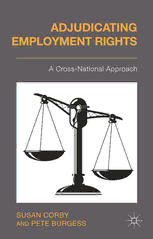
Adjudicating Employment Rights: A Cross-National Approach PDF
Preview Adjudicating Employment Rights: A Cross-National Approach
Adjudicating Employment Rights AlsobySusanCorby RETHINKINGREWARD(withStevePalmerandEsmondLindop) WORKINGFORTHESTATE(withGrahamSymon) EMPLOYEERELATIONSINTHEPUBLICSECTOR(withGeoffWhite) Adjudicating Employment Rights A Cross-National Approach Susan Corby and Pete Burgess UniversityofGreenwich,UK Chapters1–6,8–13©SusanCorbyandPeteBurgess2014 Chapter7©DanielaComandè2014 Softcover reprint of the hardcover 1st edition 2014 978-1-137-26919-5 Allrightsreserved.Noreproduction,copyortransmissionofthis publicationmaybemadewithoutwrittenpermission. Noportionofthispublicationmaybereproduced,copiedortransmitted savewithwrittenpermissionorinaccordancewiththeprovisionsofthe Copyright,DesignsandPatentsAct1988,orunderthetermsofanylicence permittinglimitedcopyingissuedbytheCopyrightLicensingAgency, SaffronHouse,6–10KirbyStreet,LondonEC1N8TS. Anypersonwhodoesanyunauthorizedactinrelationtothispublication maybeliabletocriminalprosecutionandcivilclaimsfordamages. Theauthorshaveassertedtheirrightstobeidentifiedastheauthorsofthis workinaccordancewiththeCopyright,DesignsandPatentsAct1988. Firstpublished2014by PALGRAVEMACMILLAN PalgraveMacmillanintheUKisanimprintofMacmillanPublishersLimited, registeredinEngland,companynumber785998,ofHoundmills,Basingstoke, HampshireRG216XS. PalgraveMacmillanintheUSisadivisionofStMartin’sPressLLC, 175FifthAvenue,NewYork,NY10010. PalgraveMacmillanistheglobalacademicimprintoftheabovecompanies andhascompaniesandrepresentativesthroughouttheworld. Palgrave®andMacmillan®areregisteredtrademarksintheUnitedStates, theUnitedKingdom,Europeandothercountries. ISBN 978-1-349-44383-3 ISBN 978-1-137-26920-1 (eBook) DOI 10.1057/9781137269201 Thisbookisprintedonpapersuitableforrecyclingandmadefromfully managedandsustainedforestsources.Logging,pulpingandmanufacturing processesareexpectedtoconformtotheenvironmentalregulationsofthe countryoforigin. AcataloguerecordforthisbookisavailablefromtheBritishLibrary. AcatalogrecordforthisbookisavailablefromtheLibraryofCongress. Contents ListofFiguresandTables vi Acknowledgements vii AbouttheAuthors viii 1 Introduction:IssuesandOverview 1 2 EmploymentAdjudication:ComparisonsandAnomalies 20 3 France 44 4 Germany 61 5 GreatBritain 80 6 Ireland 96 7 Italy 114 DanielaComandè 8 TheNetherlands 129 9 NewZealand 143 10 SouthAfrica 160 11 Sweden 175 12 UnitedStatesofAmerica 188 13 Evaluation:ApplyingYardsticks 206 Notes 227 References 238 Index 252 v Figures and Tables Figures 1.1 Employmentrightsadjudicationatfirstinstance 10 1.2 Thecompositionoffirst-instancelabourcourts 12 1.3 Appellatesystems 14 4.1 StructureofGermanlabourcourts 67 5.1 GreatBritain’scourtstructure 81 6.1 Ireland’scurrentadjudicationandcompliancestructure 99 6.2 Ireland’sproposedadjudicationandcompliancestructure 106 9.1 AdjudicationinNewZealand 147 10.1 AdjudicationinSouthAfrica 168 12.1 FederalcourtstructureintheUnitedStates 196 Tables 1.1 Tradeuniondensity 2 1.2 Processforresolvingnon-discriminatoryunfair dismissaldisputes 16 2.1 Employmentrightsadjudicationandexplanatorymodels 26 2.2 Labourcourtsandlegalorigins 32 2.3 Labourcourtsandnationalbusinesssystems/varieties ofcapitalism 33 2.4 Labourcourtsandindustrialrelationssystems 34 2.5 NLMsandlegalorigins 34 2.6 NLMsandnationalbusinesssystems 35 2.7 NLMsandtheindustrialrelationssystem 37 3.1 Votescastforworkerlayjudgesbyeachtradeunion 52 5.1 GBtribunals’legitimacy 89 13.1 Feesforemploymentadjudicationatfirstinstance 209 13.2 Timelimitsforfilingaclaimatfirstinstance 212 13.3 Employmentlitigationratesbasedonclaimssubmitted 214 13.4 Litigationratebasedonadjudicatoryjudgments 215 13.5 Voluntarysettlementsobtainedthrough conciliation/mediation 216 13.6 Averagelengthofproceedingsforemploymentdismissal casesatfirst-instancecourts 218 13.7 Appellateregimesforemploymentrightscases 219 13.8 Legalformality 223 vi Acknowledgements TheauthorswouldliketogiveabigthankyoutotheBusinessSchool,Uni- versity of Greenwich, London, for providing funding for this study and to Dr Daniela Comandè, University of Milan for contributing the chapter on Italy. We are grateful to our numerous interviewees in several countries who were generous in their time and often candid in their assessments of their nationalsystems. The authors would also like to thank Andrew Levy, Andre van Niekerk, Mary Stacey, Susan Mackenzie, Alistair Dumbleton, Kevin Duffy, Michael Koch, Nadine Zeibig, Frédéric Turlan and Josee Lamers who commented on draft chapters, although interpretation and errors remain the authors’ responsibility. vii About the Authors Susan Corby is Professor of Employment Relations at the University of Greenwich, UK. Formerly a trade union official, she has been a lay mem- ber of the first-instance and second-instance labour courts in Great Britain and is currently an arbitrator for a government agency (the Advisory Conciliation&ArbitrationService). Pete Burgess is a Research Fellow at the University of Greenwich, UK. He hasabackgroundinboththeacademicandprivatesectors,ininternational employment research and consultancy, and in particular comparative law, industrialrelationsandinternationalhumanresourcemanagement. DanielaComandèholdsaPhDinEuropeanlabourlawfromtheUniversity of Catania, Italy, and currently works as an assistant professor at the Uni- versity of Milan. Before then she was a post-doctoral research fellow at the EuropeanUniversityInstitute,SanDomenico,Italy. viii 1 Introduction: Issues and Overview Ourremit In all developed countries, workers are protected by statutory and/or contractual employment rights, and there are institutions for adjudicating between workers and employers should disputes arise. This book focuses solely on the organisation and operation of these institutions. We do not examineworkers’employmentrightsassuchorhowthoserightsarepubli- cised,althoughsuchprovisionscontributetotheabilityofthelawtoresolve disputes. Nor do we look at workplace institutions that provide scope for such disputes to be resolved before they enter the judicial domain, except wherethereisadirectandprescribedlinkbetweentheworkplaceandexter- nal adjudication. We leave that to other books. We define ‘adjudicating’ broadly to include decisions by a court, by an arbitral body, by an admin- istrative body or by an enforcement body and we restrict our attention to individual disputes of rights, not of interests, although in some countries thereisanoverlapintermsoftheinstitutionsused. We begin by explaining our rationale, including our rationale for mak- ing comparisons. We then discuss our methodology before providing an overview of the many institutions covered in this book. The chapter ends byoutliningthebook’sstructure. Ourrationale Why are adjudicatory institutions important today in the employment sphere? Traditionally, one of the key roles of trade unions has been to pro- tectindividualworkersandresolveworkplacedisputes.Duringthelasthalf century, however, there has been a decline in trade union density across all developed economies, although within this trend there are substantial national variations with Sweden experiencing only a slight decline com- paredwithafallofmorethanahalfintheUnitedStatesandNewZealand (seeTable1.1onp.2).Thishasbeenparalleled,althoughnotdirectly,bya 1
